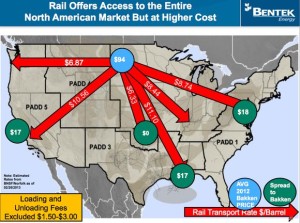Since 2012, Bakken crude transport by rail has grown significantly - today nearly 70% of all crude produced is transported to the consumer by rail.
Although pipeline transport is still critical in the Bakken, much of the movement has shifted to rail due to its overall cost effectiveness, and experts anticipate this growth to continue.
In response to this increase in rail transport, Platts, an energy news and price publisher, began offering its subscribers an assessment of value nearest the Bakken crude wellhead in late April of 2014. Platts Editorial Director Sharmilpar Kaur said in a written statement that crude transport by rail has influenced industry demand for crude value assessments closer to the wellhead.
“Given the rapid growth in the transportation of crude oil by rail, the industry was in need of Bakken Shale oil value at North Dakota terminals with the operational capacity to move crude by rail or by rail/pipeline, said Kaur.”
The service captures the value of Bakken crude at the point where there is transportation flexibility either by rail, or rail/pipeline. This assessment ultimately provides industry with greater intelligence before the decision is made on using truck, rail and/or pipeline to deliver the crude to customers.
“Founder of BakkenShale.com and industry veteran Kenny DuBose, commented, “It is important to attempt to establish pricing points as close to the wellhead as possible, in order to separate and distinguish between the commodity value and any transportation expenses.”
According to Platts, in 2016, more pipelines are expected to come online in the Bakken, which should ultimately offer industry more transportation flexibility in the region. The first Platts' Bakken price assessment was 91.93 per barrel on April 23, 2014.




